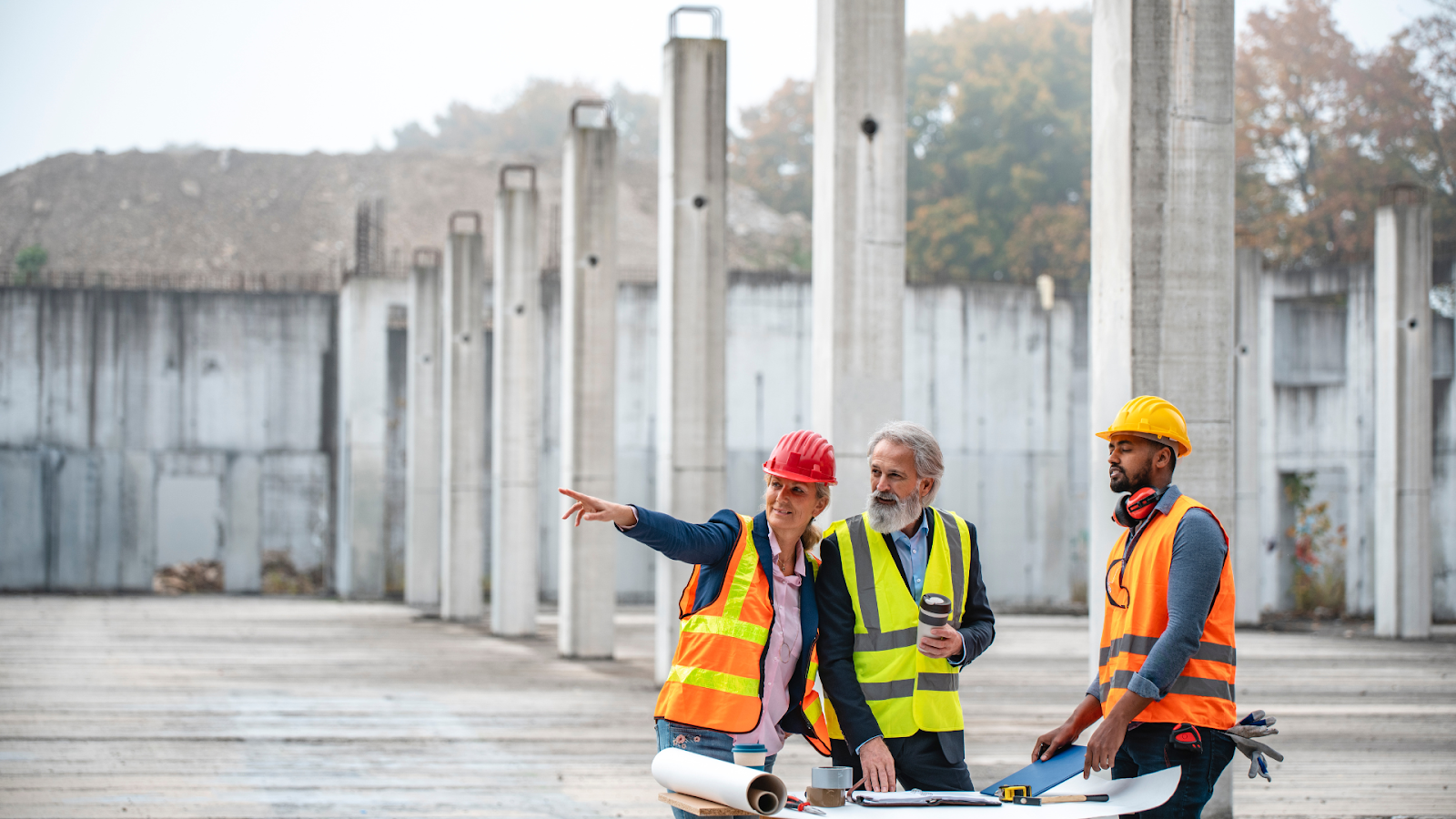With nearly half of construction projects using BIM between 76% and 100% of the time, and a quarter of respondents incorporating it into every project, it’s clear that BIM in construction project management has moved beyond being just a trend; it’s now a standard practice.
Building Information Modeling (BIM) is changing the way construction projects are designed, planned, and carried out. By providing a digital model of a project’s physical and functional aspects, BIM makes it easier to coordinate tasks, improve decision-making, and manage projects more efficiently.
In this blog, you’ll learn what BIM is in construction project management, and its benefits. You’ll also see how it’s used at each stage of a project, the challenges with solutions, important software & tools, and its future trends.
What is Building Information Modelling (BIM) in Construction Project Management?
Building Information Modelling (BIM) is a digital tool used to plan, design, and manage a construction project. It’s more than just creating Three-Dimensional (3D) models; BIM brings together all parts of the project, like design, scheduling, budgeting, and logistics, into one platform. This helps everyone involved in the project to see the entire plan and make better decisions.
BIM contains detailed information about the building, such as its size, materials, and how it will use energy. By keeping all this data in one place, BIM makes it easier for everyone, architects, builders, and managers, to work together. They can access the same up-to-date information, which helps avoid mistakes and keeps the project moving smoothly.
BIM in construction project management also comes with a range of benefits that enhance project efficiency, streamline communication, and support sustainable practices throughout the construction process.
Benefits of Using BIM in Construction Project Management
BIM offers various benefits that can significantly enhance construction project management. From improving collaboration to streamlining processes, BIM helps reduce errors, save time, and ensure more efficient project execution.
Below are some of the key benefits that make BIM a vital tool in modern construction.
- Enhanced Collaboration: BIM centralises information, enabling all project stakeholders to collaborate more effectively. This reduces misunderstandings and improves communication throughout the project.
- Improved Planning and Visualisation: BIM allows teams to visualise the construction process from the outset, helping to identify potential challenges early and plan logistics more efficiently.
- Accurate Cost Control: By providing precise data on materials and quantities, BIM helps with accurate cost estimation. It also reduces the risk of budget overruns by detecting potential issues before they arise.
- Faster Project Delivery: BIM links schedules to the 3D model, improving task sequencing and ensuring that projects are completed on time, often ahead of schedule.
- Reduced Errors and Waste: BIM identifies design clashes and simulates construction steps, which helps to minimise errors, reduce rework, and cut down on material waste.
- Increased Efficiency: BIM automates tasks like documentation and reporting, streamlining workflows. This reduces the time spent on repetitive tasks and allows teams to focus on activities that add more value.
- Support for Prefabrication: With BIM, detailed planning for off-site construction and prefabrication becomes easier. This results in quicker assembly, fewer disruptions, and better quality control.
- Improved Safety: BIM allows teams to visualise potential hazards and plan safety measures in advance, creating safer job sites. It also helps with risk management by providing real-time project data.
- Better Quality and Maintenance: BIM ensures higher build quality by providing a detailed digital model, which also simplifies future maintenance and facility management.
- Seamless Handover: Upon project completion, BIM delivers an accurate, up-to-date model to facility managers. This ensures a smooth transition to operations and long-term asset management.
BIM’s benefits go beyond just improving efficiency and communication; its real value shows when it’s used throughout different stages of a project, making the entire process run more smoothly from start to finish.
Applications of BIM Across Construction Project Stages

BIM plays a crucial role in enhancing collaboration, accuracy, and efficiency throughout every stage of a construction project. For architects, designers, contractors, builders, and others involved in construction, it’s important to understand how BIM can be used throughout the project.
The following are the applications BIM is applied at different stages of a construction project:
- Pre-Design and Planning Stage
At the start of a project, BIM helps set clear goals and bring together the right team. It helps make early decisions by creating basic models that show the project’s concept, materials, and expected costs. This makes it easier to communicate with clients and stakeholders, ensuring everyone is on the same page before moving to the detailed design phase.
- Design Stage
In the design phase, BIM enables architects and engineers to develop detailed 3D models that integrate all aspects of the project, including architecture, structure, and Mechanical, Electrical, and Plumbing (MEP) systems. It helps detect design clashes, reduce errors, and minimise rework. Additionally, BIM supports Four-Dimensional (4D) scheduling and Five-Dimensional (5D) cost estimation, helping the team stay on track and within budget. This stage is characterised by continuous collaboration, improving design quality and efficiency.
- Construction Stage
During construction, BIM provides accurate models to help with sequencing and managing materials. It lets teams track progress and ensure that what’s being built matches the design. BIM also helps manage procurement, reducing waste and delays. By detecting potential problems early, it prevents costly mistakes and promotes better teamwork between construction managers and designers.
- Operations and Maintenance Stage
Once the building is completed, BIM continues to be useful for managing the property. It keeps a digital copy of the building (a digital twin) that tracks asset details, maintenance schedules, and data for systems like Heating, Ventilation, and Air Conditioning (HVAC). BIM helps building owners and managers maintain the building more efficiently, extend its life, and reduce operating costs.
Also read: A Guide to Building Information Modelling (BIM) Impact on Modern Construction Industry.
Although BIM adds value at every stage, there are some obstacles that need to be addressed for successful implementation in construction projects.
Challenges in Implementing BIM in Construction Projects
Implementing BIM in construction projects can significantly improve project efficiency, but it’s not without its challenges. From high upfront costs to training gaps and integration issues, there are several hurdles to overcome.
Below are some of the most common challenges, along with actionable solutions to tackle them effectively:
| Challenges | Solutions |
| High Initial Costs | Begin with a pilot project to showcase BIM’s value before full-scale adoption. Consider phased implementation and explore government grants or financing options. |
| Lack of Skilled Personnel and Training | Invest in comprehensive training programmes and workshops for your team. Collaborate with training providers or hire specialists to build in-house expertise. |
| Resistance to Change | Implement change management strategies.Communicate BIM’s benefits clearly, involve stakeholders early, and share success stories to encourage adoption. |
| Interoperability Issues | Use open BIM standards like Industry Foundation Classes (IFC) to improve software compatibility. Choose tools that support these standards for better collaboration. |
| Data Management and Security | Adopt strong data management protocols, including encryption, regular backups, and access controls.Use cloud-based BIM platforms for secure data storage and easy access. |
| Complex Procedures and Workflow Integration | Develop standardised BIM protocols and provide training to ensure smooth integration with existing workflows. Regularly review and refine these processes. |
| Hardware Limitations | Evaluate current hardware and upgrade as needed to meet BIM requirements. Work with technology vendors to select compatible hardware for efficient collaboration. |
| Lack of Standardised Guidelines and Legal Framework | Follow international BIM standards and best practices.Engage with industry bodies and stay updated on evolving standards and legal guidelines. |
With the right technology, tackling BIM challenges in construction project management becomes more efficient. Software tools can help simplify tasks, enhance team collaboration, and ensure greater project precision.
Ready to simplify your projects and achieve the benefits?
BIM ASSOCIATES is your one-stop BIM Solution provider for Revit Architectural and Structural Solutions. They coordinate with your team to develop, record, and streamline the BIM Revit Model, along with the sheets, Bill of Quantities, Bill of Materials, and clash coordination.
Despite the challenges that come with adopting BIM, the availability of advanced software and tools can help address these issues, streamlining processes and enhancing overall project outcomes.
BIM Software & Tools in Construction Project Management

The adoption of BIM software tools has revolutionised how construction projects are managed, offering a range of capabilities that support everything from design and coordination to real-time collaboration and project monitoring.
These tools not only streamline processes but also help minimise errors, improve decision-making, and ensure that projects stay on track. Below are some of the most widely used BIM tools that play a crucial role in project construction management:
- Autodesk Revit
Revit is a powerful BIM tool for creating intelligent 3D models, enabling seamless design coordination and accurate construction documentation. It facilitates collaboration between architects, engineers, and contractors, helping to minimise miscommunication and optimise workflows. Revit also tracks the entire project lifecycle, from initial design to maintenance.
- Autodesk BIM 360 / Autodesk Construction Cloud (ACC)
This cloud-based platform centralises all project data, models, and documents, allowing for real-time collaboration and efficient document management. It supports version control, RFIs, submittals, and automated workflows, making it ideal for teams working across different locations and disciplines.
- Navisworks
This software allows integration of models from multiple sources, providing a comprehensive view of the project. It is especially useful for clash detection and coordination between different teams, helping to identify potential issues before construction begins. This reduces the risk of costly mistakes during the build.
- Autodesk AutoCAD
AutoCAD is versatile CAD software used for creating precise 2D drawings. It supports the design and documentation of building plans, site layouts, structural details, and infrastructure projects. With its comprehensive drafting tools and layer management, AutoCAD enables architects and engineers to produce accurate technical drawings, streamline design workflows, and ensure clarity in construction documentation. Its compatibility with other Autodesk tools also facilitates smoother collaboration across multidisciplinary teams.
- Sketchup
SketchUp is a user-friendly 3D modeling tool used in architecture and civil engineering for fast and accurate design visualization. It’s ideal for creating building models, site layouts, and conceptual designs, with support for quick iterations, realistic presentations, and integration with plugins for enhanced functionality.
- Plannerly
Plannerly streamlines the BIM management process by providing templates for BIM Execution Plans (BEPs) and setting clear requirements for project information. It ensures that the project complies with industry standards like ISO 19650, helping teams stay organised and aligned throughout the project.
- 3ds Max
3ds Max is a powerful 3D modeling and rendering tool used in architecture and civil engineering to create photorealistic visualizations and design simulations. It features advanced modeling, lighting, and texturing tools, with support for ray tracing and global illumination—ideal for detailed presentations and virtual walkthroughs.
- Revizto
Revizto enhances collaboration by making it easier to track issues and manage coordination in real-time. This tool ensures better communication among project teams, enabling faster problem-solving and reducing delays that can affect the project timeline.
Future Trends of BIM in Construction Project Management
The future of BIM in construction project management is being shaped by innovative technologies and trends that promise to further streamline processes, enhance collaboration, and improve outcomes.
Below are some of the future trends that are transforming the way construction projects are managed.
Artificial Intelligence (AI) and Machine Learning (ML) Integration
AI and ML are becoming essential to BIM. These technologies help automate tasks, predict risks, and optimise project designs. By using AI-powered BIM, teams can detect design issues early, enhance scheduling, and improve workflows, which leads to fewer mistakes and better project results.
Digital Twins
Digital twins are virtual replicas of real-world buildings or infrastructure. By connecting BIM data with sensors and IoT devices, construction projects can be monitored in real time. This gives project managers valuable insights that help predict maintenance needs and improve building performance throughout its life cycle.
Cloud-Based Collaboration
Cloud technology is changing how project teams collaborate. With cloud-based BIM platforms, everyone involved in a project can access and update information instantly, no matter where they are. This boosts communication, speeds up decision-making, and reduces mistakes caused by outdated or missing data.
Sustainability and Green Building
BIM is becoming a key player in sustainable construction. It helps architects and engineers plan energy-efficient designs, choose eco-friendly materials, and minimise waste. BIM tools can also simulate how a building will impact the environment, making it easier to create buildings that meet sustainability goals.
IoT and Smart Construction
By integrating IoT with BIM, construction sites are becoming smarter. Sensors collect real-time data on everything from equipment usage to building conditions, helping project managers make better decisions. This improves safety and boosts the overall efficiency of the construction process.
Prefabrication and Modular Construction
BIM supports prefabrication and modular construction, making the process faster and more efficient. By providing accurate digital models, BIM helps build more components off-site, which reduces construction time, costs, and waste while ensuring higher quality control.
Augmented Reality (AR) and Virtual Reality (VR)
AR and VR are enhancing the use of BIM by allowing teams to visualise projects before construction begins. These technologies help in design reviews, staff training, and on-site guidance, making it easier to spot potential issues early and improve understanding of the project.
Increased Automation and Robotics
Automation and robotics are improving the construction process by reducing manual work and cutting down on errors. When paired with BIM, these technologies speed up project delivery and enhance productivity, making construction more cost-effective.
Smart Cities
BIM is also playing an important role in the development of smart cities. It helps with planning, building, and managing urban infrastructure. By making cities more efficient and sustainable, BIM is shaping the future of urban living.
BIM Supports GREEN EARTH.
Conclusion
BIM is transforming the way construction projects are managed. It helps improve planning, communication, and coordination, making projects more efficient and accurate. BIM also supports sustainability by helping teams use resources better, reduce waste, and create more energy-efficient buildings, leading to greener construction.
As BIM technology continues to improve, its benefits for the construction industry will continue to grow. Continuing to use and develop BIM will help make future projects more efficient and environmentally friendly.
Are you looking for BIM solutions?
BIM ASSOCIATES is your one-stop BIM Solution provider for the Architecture and Structure discipline. Their solutions help clients with better decision-making, cost-saving, efficient construction planning, and green earth initiatives.
You might also like: 5D BIM in Construction: Benefits, Challenges, and Future Trends
FAQs (Frequently Asked Questions)
- Is BIM only used for large construction projects?
BIM is not just for large construction projects. It can be used for projects of any size, including small renovations, extensions, and new builds. BIM is helpful for planning, coordinating, and managing all types of construction work.
- What skills are needed to work with BIM tools?
To work with BIM tools, you need to know how to create digital models, understand construction drawings, and have basic computer skills. It’s also important to be familiar with BIM software like Revit or ArchiCAD, and have good teamwork and communication skills. Knowing how construction projects work and having project management knowledge are also helpful.
- How much does BIM software cost for construction companies?
The cost of BIM software depends on the provider, features, and number of users. Some software requires a monthly or annual subscription, while others have a one-time license fee. Prices can range from a few hundred to several thousand dollars each year, with different pricing options to suit different types of businesses.
- Can BIM help reduce construction waste?
Yes, BIM can help reduce construction waste. It provides accurate models and detailed plans, which help catch design mistakes early and improve material estimates. This results in fewer errors, less rework, and less material waste during construction.
- Are there any free BIM tools available?
Yes, there are some free BIM tools, although they tend to have fewer features compared to the paid versions. These free tools are useful for learning the basics of BIM or for smaller projects. However, for larger or more complex projects, paid BIM software is generally required to access all the features.
- How does BIM contribute to sustainable building practices?
BIM helps support sustainable building practices by improving planning and resource management. It allows teams to analyze energy use, choose sustainable materials, and optimize building design. BIM also reduces waste and helps meet green building standards by providing detailed performance data and documentation.

